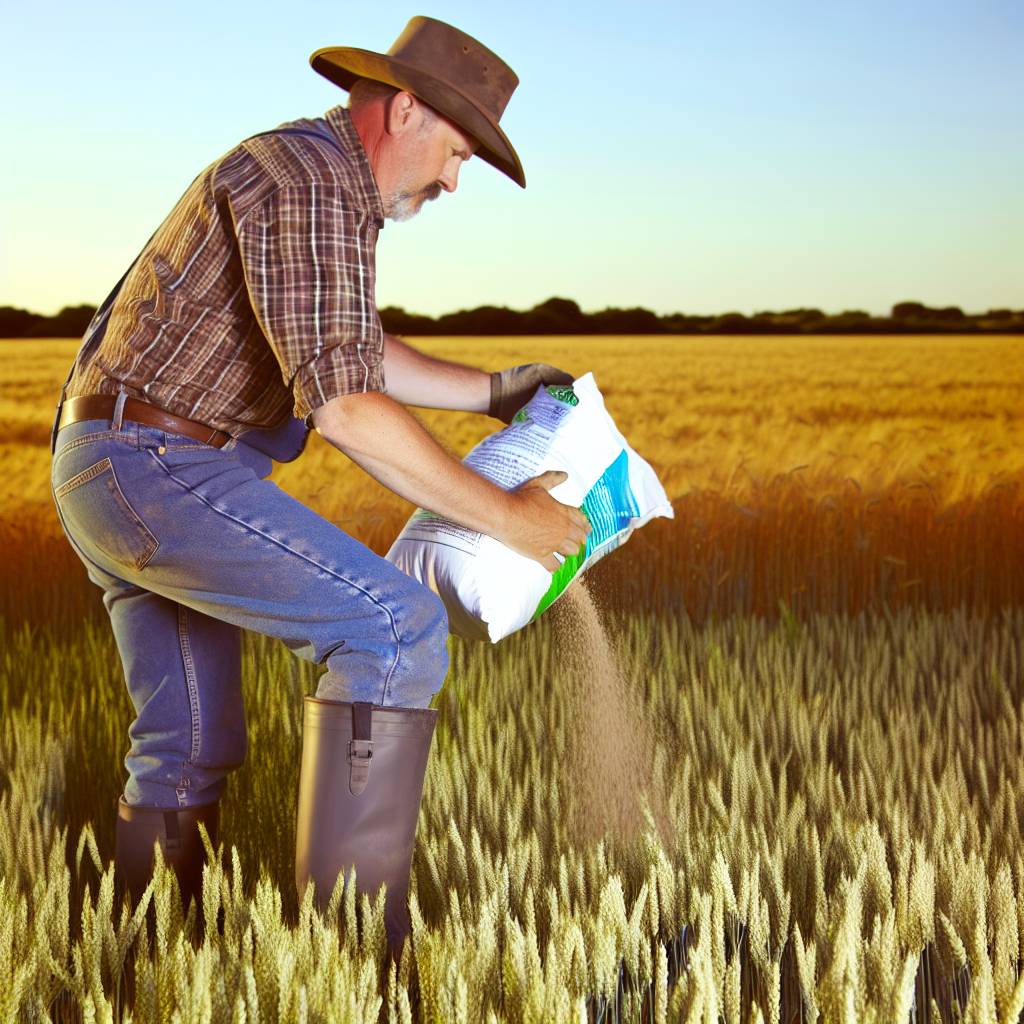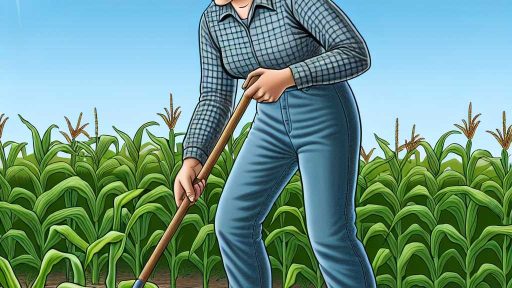Introduction to Sustainable Wheat Farming and Its Importance in the USA
Sustainable wheat farming is crucial for maintaining food security.
This approach minimizes environmental impacts while maximizing crop yield.
Farmers play a significant role in implementing sustainable practices.
These practices enhance soil health and promote biodiversity.
Additionally, sustainable methods reduce reliance on chemical inputs.
Consequently, they improve the resilience of farming systems.
In the USA, wheat is a staple crop grown across various regions.
These regions benefit economically from sustainable agricultural practices.
Moreover, sustainable farming supports local communities and economies.
It fosters the development of long-term agricultural strategies.
Farmers are increasingly adopting precision agriculture technologies.
These technologies assist in effective fertilizer management.
Furthermore, responsible fertilizer use limits nutrient runoff.
This helps protect water quality in surrounding ecosystems.
Farmers are also encouraged to use cover crops and crop rotations.
Transform Your Agribusiness
Unlock your farm's potential with expert advice tailored to your needs. Get actionable steps that drive real results.
Get StartedThese practices improve soil structure and nutrient availability.
Ultimately, sustainable wheat farming yields healthier crops.
It addresses the growing challenge of climate change.
As such, it ensures a stable supply of wheat for future generations.
Sustainable practices are vital for wheat farming.
They contribute to a healthier environment and a robust agricultural economy.
Overview of Fertilizer Types
Understanding Organic Fertilizers
Organic fertilizers originate from natural sources.
They include materials like compost, manure, and bone meal.
These fertilizers improve soil structure and health.
Additionally, they enhance microbial activity in the soil.
Farmers can benefit from using organic fertilizers in various crops.
Benefits of Organic Fertilizers
Organic fertilizers promote sustainable farming practices.
They reduce chemical runoff and pollution in waterways.
This choice leads to healthier ecosystems over time.
Furthermore, organic fertilizers can improve crop resilience.
They often provide a slow release of nutrients for plants.
Exploring Synthetic Fertilizers
Synthetic fertilizers are manufactured using chemical processes.
They typically contain concentrated amounts of nutrients like nitrogen, phosphorus, and potassium.
Farmers often favor synthetic options for their quick nutrient availability.
These fertilizers can result in rapid crop growth and increased yields.
Advantages of Synthetic Fertilizers
Synthetic fertilizers allow precise nutrient management for farmers.
They provide immediate benefits to crops during the growing season.
Additionally, they have a longer shelf life compared to organics.
Farmers can acquire specific formulas tailored to crop needs.
Showcase Your Farming Business
Publish your professional farming services profile on our blog for a one-time fee of $200 and reach a dedicated audience of farmers and agribusiness owners.
Publish Your ProfileHowever, they require careful application to prevent overuse.
Comparative Analysis of Organic and Synthetic Fertilizers
Both fertilizer types have distinct advantages and disadvantages.
Organic fertilizers improve long-term soil health and sustainability.
Meanwhile, synthetic fertilizers can enhance immediate production goals.
Farmers must assess their goals and environmental impact.
Choosing the right fertilizer often involves a blend of both types.
Soil Testing and Analysis
Importance of Soil Testing
Soil testing is crucial for wheat farming.
It helps identify the nutrient levels present in the soil.
Moreover, it reveals any deficiencies that may affect crop growth.
Understanding these factors optimizes fertilizer management.
Types of Soil Tests
Several soil tests are useful for wheat farming.
Macronutrient tests measure essential nutrients like nitrogen, phosphorus, and potassium.
Micronutrient tests evaluate trace elements like zinc and iron.
Additionally, pH tests assess soil acidity or alkalinity.
Interpreting Soil Test Results
Interpreting soil test results is vital for effective management.
Fertilizer recommendations depend on the specific nutrient levels observed.
Farmers should consult local agricultural experts for guidance.
This approach ensures that applications meet both crop needs and environmental standards.
Timing and Frequency of Testing
Soil testing should occur at regular intervals.
Annual tests are ideal to monitor changing nutrient levels.
Conduct tests before planting to plan necessary fertilizer applications.
Seasonal adjustments can further enhance nutrient optimization.
Best Practices for Soil Testing
Implementing best practices enhances the effectiveness of soil testing.
- Collect samples from multiple locations in the field.
- Ensure samples are representative of the entire area.
- Follow proper sampling techniques to avoid contamination.
- Store samples in clean, dry containers before analysis.
You Might Also Like: Greenhouse Cultivation for Reducing Water Usage in Agriculture
Best Practices for Fertilizer Application Timing and Techniques
Understanding Fertilizer Needs
Wheat crops have specific nutrient requirements at various growth stages.
Thus, it is essential to analyze soil and plant tissue before application.
Conduct soil tests to determine nutrient levels effectively.
Incorporate plant sap analysis to gauge nutrient needs during the growing season.
Timing of Fertilizer Applications
Application timing significantly influences fertilizer effectiveness.
Apply fertilizers at critical growth stages to maximize yield.
Early spring is ideal for delivering nitrogen, supporting initial growth.
For optimal results, apply additional nitrogen during the tillering phase.
Lastly, post-anthesis applications can support grain fill and improve quality.
Techniques for Effective Application
Employ various application techniques to ensure uniform distribution.
Broadcasting works well for dry fertilizers, promoting quick incorporation into soil.
Banding techniques place nutrients closer to plant roots, enhancing efficiency.
Utilize foliar applications for quick nutrient uptake during critical growth periods.
Incorporating Organic Fertilizers
Integrating organic fertilizers can benefit sustainability efforts.
Organic matter improves soil structure and water retention.
Additionally, it fosters microbial activity essential for nutrient cycling.
Showcase Your Farming Business
Publish your professional farming services profile on our blog for a one-time fee of $200 and reach a dedicated audience of farmers and agribusiness owners.
Publish Your ProfileConsider compost or manure as viable sources for boosting soil fertility.
Monitoring and Adjusting Fertilizer Practices
Continuous monitoring ensures fertilizer practices remain effective.
Keep records of crop performance and soil health for evaluation.
Adjust fertilization practices according to environmental conditions and crop response.
Engage with agronomists for expert advice and tailored recommendations.
Find Out More: Pest And Disease Forecasting For Effective Crop Management
The Role of Crop Rotation in Improving Soil Fertility
Understanding Crop Rotation
Crop rotation involves alternating different crops in a specific sequence.
This practice enhances soil fertility and health over time.
Furthermore, it reduces the risk of crop diseases significantly.
Benefits of Crop Rotation
Rotating crops can improve soil structure and nutrient availability.
Different crops have varying nutrient needs.
For example, legumes can fix nitrogen in the soil.
This increases the available nitrogen for subsequent crops.
In addition, crop rotation helps manage weeds more effectively.
Reduces Pests and Diseases
Crop rotation disrupts the lifecycle of pests and diseases.
For instance, if a plant pest thrives on a specific crop, rotating that crop can help manage their population.
This leads to healthier crops and reduced need for chemical pesticides.
Enhances Biodiversity
By rotating crops, farmers promote biodiversity within their fields.
This diversity strengthens the ecosystem and promotes beneficial organisms.
Consequently, this creates a more resilient farming system overall.
Practical Implementation
Farmers should develop a crop rotation plan tailored to their specific regions.
They must consider climate, soil type, and market demand when planning.
Furthermore, documenting crop rotations can help in assessing their effectiveness.
Examples of Effective Crop Rotations
- Corn followed by soybeans is a common rotation.
- Wheat can be rotated with oats and legumes.
- Root vegetables can follow leafy greens for optimal results.
See Related Content: Essential Mulching Practices for Successful Farming
Impact of Over-fertilization on Environment and Crop Yield
Understanding Over-fertilization
Over-fertilization occurs when farmers apply too much fertilizer to their crops.
This practice often leads to nutrient runoff into nearby water bodies.
As a result, it causes water pollution and algal blooms.
These blooms deplete oxygen levels in the water, harming aquatic life.
Moreover, over-fertilization can disrupt soil health and biodiversity.
Effects on Crop Yield
Ironically, excessive fertilizer can decrease crop yield over time.
High nutrient levels can lead to crop diseases and pest infestations.
This situation ultimately results in reduced overall productivity.
Additionally, plants may become reliant on fertilizers instead of natural soil nutrients.
Environmental Consequences
The environmental impact of over-fertilization is significant.
It contributes to the contamination of groundwater sources.
This contamination poses health risks for human and animal populations.
Furthermore, it can lead to decreased soil fertility in the long term.
Sustainable farming practices can mitigate these adverse effects.
Strategies for Sustainable Fertilizer Use
Farmers can adopt several strategies to manage fertilizer use effectively.
- Soil testing helps determine the necessary nutrient levels.
- Using cover crops can improve soil health and reduce nutrient runoff.
- Implementing precision agriculture techniques optimizes fertilizer application.
- Crop rotation can enhance soil structure and fertility over time.
These strategies promote sustainability in wheat farming.
Showcase Your Farming Business
Publish your professional farming services profile on our blog for a one-time fee of $200 and reach a dedicated audience of farmers and agribusiness owners.
Publish Your ProfileUltimately, they enhance both crop yield and environmental health.
Gain More Insights: Innovative Packaging Ideas to Extend Shelf Life

Integration of Cover Crops to Enhance Nutrient Uptake and Soil Health
Understanding Cover Crops
Cover crops are planted primarily to benefit the soil rather than for harvest.
They help improve soil structure and fertility.
In addition, cover crops can minimize soil erosion.
Farmers often use legumes and grasses as cover crops.
Benefits of Cover Crops
Cover crops enhance nutrient cycling in the soil.
They allow for better nutrient uptake by subsequent crops.
Moreover, cover crops can suppress weed growth.
They also improve soil moisture retention.
Types of Cover Crops
Diverse types of cover crops suit different farming needs.
For instance, clover is a nitrogen-fixing legume.
Rye is excellent for its rapid growth and erosion control.
Other crops include hairy vetch and buckwheat.
Incorporating Cover Crops into Wheat Farming
Integrating cover crops can significantly benefit wheat farming.
Farmers can plant cover crops in the off-season.
This strategy enriches the soil before planting wheat.
Besides improving soil health, cover crops lower weed pressure.
Best Management Practices
Effective management practices maximize the benefits of cover crops.
Farmers should select cover crops based on local conditions.
They can also adjust planting and termination dates to fit their schedules.
Additionally, combining different species can enhance benefits.
Monitoring Soil Health
Regular soil testing supports effective nutrient management.
Farmers can determine the nutrient levels and pH balance.
Monitoring allows for adjustments to cover crop choices.
It helps in understanding long-term soil health trends.
Building a Sustainable Future
Utilizing cover crops is a step towards sustainable wheat farming.
This practice promotes both environmental health and agricultural productivity.
As farmers adopt cover cropping, they protect vital resources.
These efforts contribute to a more resilient agricultural system.
Economic Considerations
Cost-Benefit Analysis of Fertilizer Management
Effective fertilizer management is crucial for sustainable wheat farming.
Farmers must assess both the costs and benefits of their fertilizer choices.
Understanding these factors helps improve profitability and sustainability.
Evaluating Costs
The costs of fertilizers include purchasing, transport, and application.
Farmers must also consider the potential for nutrient runoff.
This runoff can lead to additional environmental costs.
Moreover, proper storage and handling can incur extra expenses.
Analyzing Benefits
Higher yields are a primary benefit of effective fertilizer management.
Investing in the right fertilizers can boost crop quality notably.
Moreover, improved soil health leads to long-term agricultural benefits.
Showcase Your Farming Business
Publish your professional farming services profile on our blog for a one-time fee of $200 and reach a dedicated audience of farmers and agribusiness owners.
Publish Your ProfileFarmers may also enjoy reduced soil erosion through better practices.
Return on Investment
Calculating the return on investment (ROI) is essential.
Farmers should compare the gains from improved yields against fertilization costs.
Higher ROI indicates a more sustainable approach to fertilizer use.
Long-term Economic Sustainability
Sustainable practices foster long-term economic viability.
Farmers should aim for balanced fertilizer applications to maintain soil health.
Implementing sustainable practices can attract premium prices for organic products.
Ultimately, this approach benefits both the environment and the economy.
Case Studies: Successful Sustainable Wheat Farms in the USA
Innovative Farming Techniques
Many sustainable wheat farms use innovative techniques to boost yields.
Crop rotation forms a crucial part of their practices.
This method enhances soil health and reduces pests.
Cover cropping also plays a significant role.
Farmers plant cover crops to increase organic matter in the soil.
Consequently, this reduces the need for synthetic fertilizers.
Example of Green Valley Farms
Green Valley Farms in Nebraska embraces sustainable practices.
They have increased wheat yields while improving soil health.
Farmers at Green Valley engage in frequent soil testing.
This testing helps them tailor fertilizer application precisely.
Moreover, they utilize compost and organic matter effectively.
Family Farms Leading the Way
The Thompson family farm in Kansas showcases sustainable methods.
They follow a no-till farming approach to minimize soil disturbance.
This practice boosts moisture retention and reduces erosion.
Furthermore, they implement an integrated pest management system.
This system focuses on using natural pest control methods.
Holistic Management at Oak Ridge Farm
Oak Ridge Farm in Minnesota exemplifies holistic management practices.
Their strategy incorporates livestock and crop integration.
This integration enhances nutrient cycling on the farm.
Additionally, they prioritize biodiversity through varied crops.
Their approach results in healthier ecosystems and profitable yields.
Community Engagement and Education
Successful farms often engage with their communities.
Educational workshops help spread sustainable practices.
Farm tours allow consumers to learn about sustainable farming.
These efforts build a stronger relationship between farmers and consumers.
Consequently, community support for sustainable practices grows.




